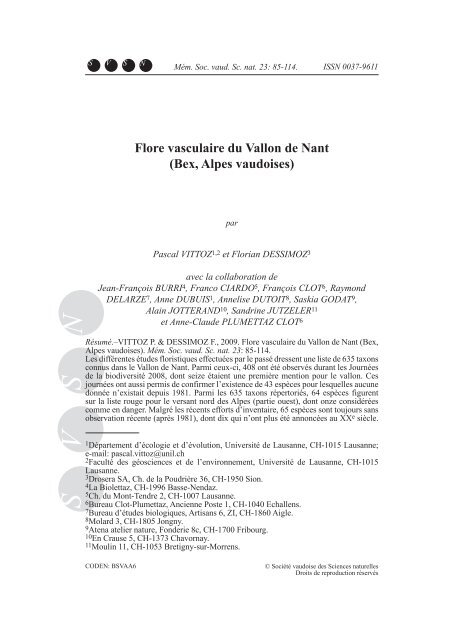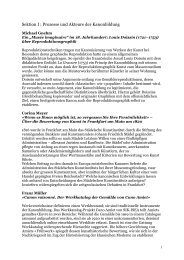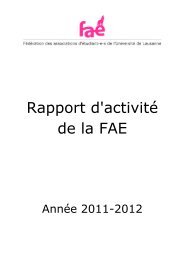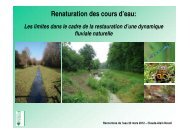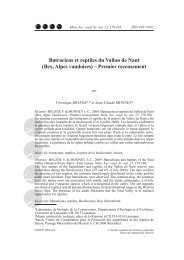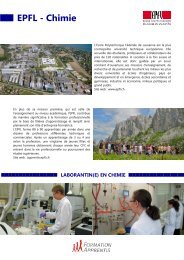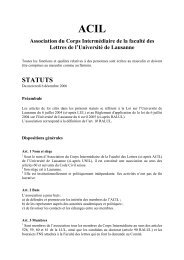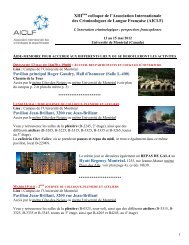Flore vasculaire du Vallon de Nant (Bex, Alpes vaudoises)
Flore vasculaire du Vallon de Nant (Bex, Alpes vaudoises)
Flore vasculaire du Vallon de Nant (Bex, Alpes vaudoises)
You also want an ePaper? Increase the reach of your titles
YUMPU automatically turns print PDFs into web optimized ePapers that Google loves.
Mém. Soc. vaud. Sc. nat. 23: 85-114.<br />
ISSN 0037-9611<br />
<strong>Flore</strong> <strong>vasculaire</strong> <strong>du</strong> <strong>Vallon</strong> <strong>de</strong> <strong>Nant</strong><br />
(<strong>Bex</strong>, <strong>Alpes</strong> <strong>vaudoises</strong>)<br />
par<br />
Pascal VITTOZ 1,2 et Florian DESSIMOZ 3<br />
avec la collaboration <strong>de</strong><br />
Jean-François Burri 4 , Franco Ciardo 5 , François Clot 6 , Raymond<br />
Delarze 7 , Anne Dubuis 1 , Annelise Dutoit 8 , Saskia Godat 9 ,<br />
Alain Jotterand 10 , Sandrine Jutzeler 11<br />
et Anne-Clau<strong>de</strong> Plumettaz Clot 6<br />
Résumé.–VITTOZ P. & DESSIMOZ F., 2009. <strong>Flore</strong> <strong>vasculaire</strong> <strong>du</strong> <strong>Vallon</strong> <strong>de</strong> <strong>Nant</strong> (<strong>Bex</strong>,<br />
<strong>Alpes</strong> <strong>vaudoises</strong>). Mém. Soc. vaud. Sc. nat. 23: 85-114.<br />
Les différentes étu<strong>de</strong>s floristiques effectuées par le passé dressent une liste <strong>de</strong> 635 taxons<br />
connus dans le <strong>Vallon</strong> <strong>de</strong> <strong>Nant</strong>. Parmi ceux-ci, 408 ont été observés <strong>du</strong>rant les Journées<br />
<strong>de</strong> la biodiversité 2008, dont seize étaient une première mention pour le vallon. Ces<br />
journées ont aussi permis <strong>de</strong> confirmer l’existence <strong>de</strong> 43 espèces pour lesquelles aucune<br />
donnée n’existait <strong>de</strong>puis 1981. Parmi les 635 taxons répertoriés, 64 espèces figurent<br />
sur la liste rouge pour le versant nord <strong>de</strong>s <strong>Alpes</strong> (partie ouest), dont onze considérées<br />
comme en danger. Malgré les récents efforts d’inventaire, 65 espèces sont toujours sans<br />
observation récente (après 1981), dont dix qui n’ont plus été annoncées au XX e siècle.<br />
1 Département d’écologie et d’évolution, Université <strong>de</strong> Lausanne, CH-1015 Lausanne;<br />
e-mail: pascal.vittoz@unil.ch<br />
2 Faculté <strong>de</strong>s géosciences et <strong>de</strong> l’environnement, Université <strong>de</strong> Lausanne, CH-1015<br />
Lausanne.<br />
3 Drosera SA, Ch. <strong>de</strong> la Poudrière 36, CH-1950 Sion.<br />
4 La Biolettaz, CH-1996 Basse-Nendaz.<br />
5 Ch. <strong>du</strong> Mont-Tendre 2, CH-1007 Lausanne.<br />
6 Bureau Clot-Plumettaz, Ancienne Poste 1, CH-1040 Echallens.<br />
7 Bureau d’étu<strong>de</strong>s biologiques, Artisans 6, ZI, CH-1860 Aigle.<br />
8 Molard 3, CH-1805 Jongny.<br />
9 Atena atelier nature, Fon<strong>de</strong>rie 8c, CH-1700 Fribourg.<br />
10 En Crause 5, CH-1373 Chavornay.<br />
11 Moulin 11, CH-1053 Bretigny-sur-Morrens.<br />
CODEN: BSVAA6<br />
© Société vaudoise <strong>de</strong>s Sciences naturelles<br />
Droits <strong>de</strong> repro<strong>du</strong>ction réservés
86<br />
P. Vittoz et F. Dessimoz<br />
Une recherche assi<strong>du</strong>e <strong>de</strong> celles-ci serait utile afin <strong>de</strong> confirmer leur présence dans la<br />
région. Cependant, étant donné le manque <strong>de</strong> précision <strong>de</strong> certaines données anciennes,<br />
il est possible que quelques espèces n’aient jamais été présentes directement dans le<br />
vallon, mais uniquement à proximité.<br />
Mots clés: angiospermes, gymnospermes, Ptéridophytes, alpin, subalpin, Journée <strong>de</strong> la<br />
biodiversité, Suisse.<br />
Abstract.–VITTOZ P. & DESSIMOZ F., 2009. Vascular plants of the <strong>Vallon</strong> <strong>de</strong> <strong>Nant</strong><br />
(Western Swiss Alps). Mém. Soc. vaud. Sc. nat. 23: 85-114.<br />
Past floristic studies in <strong>Vallon</strong> <strong>de</strong> <strong>Nant</strong> have yiel<strong>de</strong>d a list of 635 taxa. Among them,<br />
408 were observed <strong>du</strong>ring the Biodiversity Days on the 5 th and 6 th of July 2008, and an<br />
additional sixteen taxa were new records for the valley. Of the 635 recor<strong>de</strong>d taxa, 64 are<br />
on the red list for the Northern Swiss Alps (western part), including eleven endangered<br />
taxa. Despite numerous recent inventories in the valley, 65 taxa have not been recor<strong>de</strong>d<br />
since 1981 and an additional ten taxa were not recor<strong>de</strong>d <strong>du</strong>ring the 20 th century. A<br />
persevering search would be useful to confirm their presence in the region. Due to poor<br />
location precision in old records, it is possible that some of these species were never<br />
directly in the valley but only in the close surroundings.<br />
Keywords: angiosperms, gymnosperms, Pteridophytes, alpine, subalpine, Biodiversity<br />
Day, Switzerland.<br />
Intro<strong>du</strong>ction<br />
Les 5 et 6 juillet 2008 ont été organisées les Journées <strong>de</strong> la biodiversité dans<br />
le <strong>Vallon</strong> <strong>de</strong> <strong>Nant</strong> afin <strong>de</strong> dresser une liste aussi complète que possible <strong>de</strong> la<br />
richesse floristique et faunistique <strong>de</strong> la région (Vittoz & Gmür 2009). Avant<br />
ces journées, les plantes <strong>vasculaire</strong>s étaient certainement déjà le groupe le<br />
mieux connu dans la région. En effet, les environs <strong>de</strong> <strong>Bex</strong> sont célèbres <strong>de</strong>puis<br />
longtemps parmi les botanistes et nombreux sont ceux qui sont déjà passés par<br />
le <strong>Vallon</strong> <strong>de</strong> <strong>Nant</strong> (Pilet 1979). Albert <strong>de</strong> Haller, directeur <strong>de</strong>s salines <strong>de</strong> <strong>Bex</strong><br />
<strong>de</strong> 1758 à 1764, fut un <strong>de</strong>s premiers et certainement un <strong>de</strong>s plus célèbres. Il fit<br />
visiter la région à <strong>de</strong> nombreux scientifiques. Selon Cosan<strong>de</strong>y (1942), il serait à<br />
l’origine <strong>du</strong> rayonnement <strong>de</strong> la famille Thomas qui pendant quatre générations<br />
(1810-1900) tint un commerce <strong>de</strong> plantes et <strong>de</strong> graines à <strong>Bex</strong> (Moret 1993,<br />
in press). Ils ont laissé surtout <strong>de</strong>s listes <strong>de</strong> graines à vendre, dont beaucoup<br />
provenaient <strong>de</strong> la région (liste <strong>de</strong>s catalogues dans Moret 1993), ainsi qu’une<br />
liste manuscrite <strong>de</strong> la flore régionale (Thomas & <strong>de</strong> Charpentier 1832).<br />
Gaudin (1833), dans sa flore <strong>de</strong> Suisse, montre que la région est déjà<br />
botaniquement bien connue, avec <strong>de</strong> nombreuses observations données <strong>du</strong> côté<br />
<strong>de</strong> Javerne, Le Richard ou La Vare. Le <strong>Vallon</strong> <strong>de</strong> <strong>Nant</strong> n’y apparaît que sous<br />
la dénomination «Martinets», regroupant probablement les Dents <strong>de</strong> Morcles,<br />
la Grand Vire sur la face sud-ouest et les Martinets sur la face nord. Vingtsept<br />
espèces y sont signalées, mélangeant <strong>de</strong>s espèces alpines (par ex. Salix<br />
herbacea ou Saxifraga biflora) et subalpines (par ex. Delphinium elatum ou
<strong>Flore</strong> <strong>du</strong> <strong>Vallon</strong> <strong>de</strong> <strong>Nant</strong> 87<br />
Salix helevtica). La flore <strong>du</strong> canton <strong>de</strong> Vaud <strong>de</strong> Blanchet (1836) donne <strong>de</strong><br />
nombreuses stations dans les <strong>Alpes</strong> <strong>vaudoises</strong>, mais ne mentionne visiblement<br />
que le glacier <strong>de</strong>s Martinets dans le vallon. Cinquante ans plus tard, Durand &<br />
Pittier (1882) sont un peu plus précis dans leur Catalogue <strong>de</strong> la flore vaudoise,<br />
mais là encore, les indications spécifiques au vallon sont peu fréquentes.<br />
Néanmoins, ces indications sont particulièrement utiles pour certaines espèces,<br />
comme Murbeckiella pinnatifida ou Salix glaucosericea, sachant qu’elles<br />
n’y ont jamais été signalées <strong>de</strong>puis. Par contre, la flore <strong>du</strong> Valais <strong>de</strong> Jaccard<br />
(1895), qui débor<strong>de</strong> régulièrement dans les montagnes <strong>vaudoises</strong>, a l’avantage<br />
<strong>de</strong> donner <strong>de</strong>s indications généralement plus précises et souvent provenant<br />
d’observations directes <strong>de</strong> l’auteur, contrairement aux auteurs précé<strong>de</strong>nts qui<br />
citent surtout leurs prédécesseurs.<br />
Au XX e siècle, Michel (1935) s’intéressa à la colonisation <strong>de</strong>s gros<br />
blocs, en effectuant <strong>de</strong>s relevés phytosociologiques <strong>de</strong>s lichens, mousses et<br />
plantes <strong>vasculaire</strong>s. Mais l’étu<strong>de</strong> botanique la plus importante consacrée au<br />
<strong>Vallon</strong> <strong>de</strong> <strong>Nant</strong> est celle <strong>de</strong> Dutoit (1983). Elle décrivit et cartographia la<br />
végétation <strong>de</strong> la partie subalpine <strong>du</strong> vallon sur la base <strong>de</strong> plus <strong>de</strong> 230 relevés<br />
phytosociologiques. Ses relevés, comme ceux <strong>de</strong> Michel (1935), n’ont<br />
cependant, à notre connaissance, jamais été complétement informatisés.<br />
Dans la secon<strong>de</strong> moitié <strong>du</strong> XX e siècle, d’autres travaux ont été consacrés à<br />
la flore et la végétation <strong>de</strong>s Préalpes et <strong>Alpes</strong> <strong>vaudoises</strong>, comme l’inventaire<br />
<strong>de</strong> la région d’Anzeindaz (Villaret 1956), une brève étu<strong>de</strong> sur les chênaies<br />
<strong>de</strong>s Ormonts (Neithardt 1975), les relevés phytosociologiques <strong>de</strong>s forêts<br />
<strong>vaudoises</strong> (S. Meier; non publié), la cartographie <strong>du</strong> Pays-d’Enhaut (Clot<br />
et al. 1997), dont les relevés floristiques semblent avoir été per<strong>du</strong>s, l’étu<strong>de</strong><br />
phytosociologique <strong>de</strong>s bas-marais chablaisiens par Giugni (1991) et <strong>de</strong>s<br />
érablaies <strong>de</strong>s Préalpes occi<strong>de</strong>ntales par Clot (1989). Finalement, Villaret<br />
& Villaret-von Rochow (1958) ont publié un diagramme pollinique pour<br />
Anzeindaz remontant au Dryas récent.<br />
Les données floristiques à disposition pour le <strong>Vallon</strong> <strong>de</strong> <strong>Nant</strong> ont fortement<br />
augmenté ces huit <strong>de</strong>rnières années. Tout d’abord, Randin (2002) a répété<br />
la cartographie fine <strong>de</strong> la zone alluviale <strong>de</strong> <strong>Nant</strong> (Dutoit 1983). Mais c’est<br />
avant tout dans le cadre <strong>du</strong> projet MODIPLANT, dirigé par le professeur<br />
Antoine Guisan (Guisan 2005), que la connaissance <strong>de</strong> la flore <strong>du</strong> vallon a<br />
bien progressé. Durant les cinq premières années <strong>du</strong> projet (2002-2006), plus<br />
<strong>de</strong> 600 relevés exhaustifs et géoréférencés ont été effectués dans l’ensemble<br />
<strong>de</strong>s <strong>Alpes</strong> et Préalpes <strong>vaudoises</strong>, dont 45 dans le <strong>Vallon</strong> <strong>de</strong> <strong>Nant</strong>. Ce projet<br />
vise l’étu<strong>de</strong> et la modélisation <strong>de</strong> la répartition <strong>de</strong> la flore, actuellement et<br />
en 2100, sous l’influence <strong>du</strong> réchauffement climatique (Engler et al. 2009;<br />
Randin et al. in press a, b, c). Simultanément, 19 relevés <strong>de</strong> Dutoit (1983)<br />
ont été localisés précisément et les inventaires refaits au même endroit afin<br />
d’étudier les changements déjà observables dans la flore et la végétation <strong>du</strong>
88<br />
P. Vittoz et F. Dessimoz<br />
vallon (Vittoz et al. 2009). Etant donné que <strong>de</strong>s modèles prédictifs sans<br />
moyen <strong>de</strong> suivi et d’évaluation <strong>de</strong> leur prédictions futures sont d’une utilité<br />
limitée, l’ensemble <strong>de</strong> ces recherches a été complété par la mise en place <strong>de</strong><br />
relevés permanents le long <strong>de</strong> cinq transects situés <strong>du</strong> Jura aux <strong>Alpes</strong> centrales<br />
(projet PERMANENT.PLOT.CH; Vittoz et Guisan 2003). Un <strong>de</strong> ces transects<br />
se trouve dans le vallon et ses environs, entre 520 et 2640 m, et compte<br />
25 placettes dans <strong>de</strong>s forêts (le Montet, Plan Saugey, les Traverses, Boix <strong>du</strong><br />
Ban, le Planard, les Crots, Cinglo), pâturages (Pont <strong>de</strong> <strong>Nant</strong>, le Richard, les<br />
Etroits, <strong>Nant</strong>, les Larzettes, La Chaux) et pelouses alpines (La Chaux-<strong>de</strong> <strong>Nant</strong>,<br />
les Creux, Pointe <strong>de</strong>s Martinets).<br />
Finalement, l’herbier <strong>du</strong> Musée botanique cantonal à Lausanne constitue une<br />
autre source d’information pour la flore <strong>du</strong> <strong>Vallon</strong> <strong>de</strong> <strong>Nant</strong>. Maillefer (année<br />
inconnue) en a fait un recensement jamais publié, qui nous a été fort utile<br />
pour préciser la répartition <strong>de</strong> quelques espèces rares sans indication récente.<br />
Néanmoins, ce recensement ne couvre pas toutes les familles et il y aurait<br />
évi<strong>de</strong>mment un gros travail nécessaire pour utiliser l’ensemble <strong>de</strong>s récoltes<br />
faites dans le <strong>Vallon</strong> <strong>de</strong> <strong>Nant</strong>. L’enregistrement informatisé <strong>de</strong> l’herbier vaudois<br />
(Moret 2007), qui couvre actuellement 28’000 parts d’herbier sur les 200’000<br />
entreposées, contient environ 850 échantillons provenant <strong>de</strong> la région <strong>de</strong> <strong>Nant</strong>.<br />
Jean Muret (récoltes aux environs <strong>de</strong> 1834-1874), Eugène Rambert (1850-<br />
1885), Ernest Wilczek (1892-1948), Arthur Maillefer (1901-1952) et Annelise<br />
Dutoit (1968-1978) sont les principaux contributeurs. Ces données n’ont<br />
cependant pu être incluses dans l’inventaire <strong>de</strong>s espèces <strong>du</strong> vallon qu’après les<br />
Journées <strong>de</strong> la biodiversité. Certaines observations anciennes n’ont donc pas<br />
pu être spécifiquement vérifiées sur le terrain.<br />
A la veille <strong>de</strong>s Journées <strong>de</strong> la biodiversité 2008, 584 taxons <strong>de</strong> plantes<br />
<strong>vasculaire</strong>s nous étaient connus dans le <strong>Vallon</strong> <strong>de</strong> <strong>Nant</strong>. Cependant, 56 n’avaient<br />
plus été observés après 1981 et méritaient donc vérification (35 espèces sont<br />
venues s’ajouter après incorporation <strong>de</strong>s données <strong>de</strong> l’herbier). De plus, une<br />
fois toutes les observations connues reportées sur une carte, <strong>de</strong> larges espaces<br />
apparaissaient comme vierges <strong>de</strong> données. Du point <strong>de</strong> vue botanique, les <strong>de</strong>ux<br />
principaux buts <strong>de</strong>s Journées <strong>de</strong> la biodiversité étaient donc <strong>de</strong> visiter <strong>de</strong>s secteurs<br />
accessibles mais encore peu connus afin <strong>de</strong> rechercher d’éventuelles nouvelles<br />
espèces pour le vallon, et <strong>de</strong> vérifier la présence d’espèces connues mais sans<br />
observation récente pour mettre en œuvre <strong>de</strong>s mesures <strong>de</strong> protection si nécessaire.<br />
Figure 1.–Bien que connue dans le <strong>Vallon</strong> <strong>de</strong> <strong>Nant</strong> par certains botanistes, Aquilegia<br />
alpina n’y avait plus été officiellement signalée <strong>de</strong>puis Jaccard (1895). (Photo: M. Vust).<br />
Figure 2.–Cynoglossum officinale a été observée pour la première fois au <strong>Vallon</strong> <strong>de</strong><br />
<strong>Nant</strong> lors <strong>de</strong>s Journées <strong>de</strong> la biodiversité. (Photo: F. Dessimoz).<br />
Figure 3.–Gentiana asclepia<strong>de</strong>a, une <strong>de</strong>s belles espèces <strong>de</strong> montagne, abondante entre<br />
<strong>Nant</strong> et Pont <strong>de</strong> <strong>Nant</strong>. A voir en août-septembre. (Photo: P. Vittoz).<br />
Figure 4.–Ononis rotundifolia passe juste la crête <strong>de</strong>s <strong>Alpes</strong>. L’espèce est donc considérée<br />
comme en danger au nord <strong>de</strong>s <strong>Alpes</strong> mais fréquente en Valais. (Photo: P. Vittoz).
<strong>Flore</strong> <strong>du</strong> <strong>Vallon</strong> <strong>de</strong> <strong>Nant</strong> 89<br />
1 2<br />
3<br />
4
90<br />
P. Vittoz et F. Dessimoz<br />
Méthodologie<br />
En préparation <strong>de</strong>s Journées <strong>de</strong> la biodiversité, nous avons réuni dans une base<br />
<strong>de</strong> données toutes les observations déjà informatisées, soit essentiellement<br />
les données connues <strong>du</strong> Centre <strong>du</strong> réseau suisse <strong>de</strong> floristique (CRSF, w.ww.<br />
crsf.ch), les relevés phytosociologiques <strong>de</strong>s forêts <strong>vaudoises</strong> et les projets<br />
MODIPLANT et PERMANENT.PLOT.CH. Par manque <strong>de</strong> temps pour saisir<br />
l’entier <strong>de</strong>s tableaux contenus dans le travail <strong>de</strong> Dutoit (1983), nous nous<br />
sommes contentés <strong>de</strong> prendre note <strong>de</strong>s espèces peu communes présentes dans<br />
ces tableaux. De toutes les observations régionales à notre disposition, ont été<br />
retenues les espèces présentes dans les limites <strong>de</strong> la réserve naturelle ou à moins<br />
<strong>de</strong> 50 m. Cette marge <strong>de</strong> sécurité a été choisie pour éviter l’oubli d’espèces<br />
particulières situées sur les cols et dont les coordonnées pourraient ne pas être<br />
tout à fait exactes. Cela implique évi<strong>de</strong>mment le risque <strong>de</strong> rattacher quelques<br />
espèces absentes <strong>du</strong> vallon même, mais étant donné que plusieurs <strong>de</strong>s espèces<br />
concernées sont rares dans la région, nous avons estimé plus intéressant <strong>de</strong> les<br />
inclure par erreur que <strong>de</strong> les négliger.<br />
De cette base <strong>de</strong> données, <strong>de</strong>ux listes <strong>de</strong> plantes ont été extraites avec leurs<br />
coordonnées respectives. La première contenait 101 observations d’espèces<br />
menacées selon la Liste rouge (Moser et al. 2002) ou d’espèces dont la présence<br />
était douteuse (taxons non connus ailleurs dans les <strong>Alpes</strong> occi<strong>de</strong>ntales). La<br />
secon<strong>de</strong> liste contenait 69 observations d’espèces non signalées dans le <strong>Vallon</strong><br />
<strong>de</strong> <strong>Nant</strong> après 1981 (date limite utilisée par le CRSF pour les observations<br />
récentes, correspond à la publication <strong>de</strong> Welten & Sutter (1982)). Ces<br />
<strong>de</strong>ux listes et la localisation <strong>de</strong>s observations sur une carte topographique<br />
ont été distribuées aux participants. Sur cette carte étaient ajoutées les quinze<br />
placettes <strong>de</strong> référence proposées dans le cadre <strong>de</strong>s Journées <strong>de</strong> la biodiversité<br />
(Vittoz & Gmür 2009) et sept secteurs complémentaires approximativement<br />
délimités pour lesquelles aucune observation botanique n’était à disposition:<br />
Lués <strong>de</strong> la Larze (574’800/121’200), la Percée (573’400/120’600), Pointe <strong>de</strong>s<br />
Savolaires (572’900/120’500), la Tsabou (574’500/119’900), sous la Pointe<br />
<strong>de</strong> Pré Fleuri (572’300/119’000), les Ayers (573’100/118’400) et les Martinets<br />
(573’000/117’600).<br />
Pendant les Journées <strong>de</strong> la biodiversité, les douze botanistes se sont répartis<br />
par groupes, <strong>de</strong> <strong>de</strong>ux à trois, les placettes <strong>de</strong> référence et les sept secteurs<br />
complémentaires. Les placettes ont été inventoriées dans un rayon <strong>de</strong> 20 m<br />
environ autour <strong>du</strong> centre défini par un repère et les secteurs sous la forme d’un<br />
ou <strong>de</strong> plusieurs inventaires géoréférencés dans la surface proposée. Dans les<br />
<strong>de</strong>ux cas, l’abondance <strong>de</strong>s espèces était estimée, à choix, sur la base <strong>de</strong> l’échelle<br />
<strong>de</strong> Braun-Blanquet (1964) ou <strong>du</strong> nombre d’indivi<strong>du</strong>s selon les catégories<br />
<strong>du</strong> CRSF (1-10, 11-25, 26-50, 51-100, 101-200, > 200 exemplaires). De plus,<br />
les groupes étaient invités à faire <strong>de</strong>s détours lors <strong>de</strong> leurs déplacements pour<br />
vérifier certaines espèces douteuses, <strong>de</strong> la liste rouge ou non revues <strong>de</strong>puis
<strong>Flore</strong> <strong>du</strong> <strong>Vallon</strong> <strong>de</strong> <strong>Nant</strong> 91<br />
a<br />
b<br />
c<br />
d<br />
e<br />
f<br />
h<br />
g<br />
Figure 5.–Espèces pouvant être observées dans le <strong>Vallon</strong> <strong>de</strong> <strong>Nant</strong>:<br />
a. Leontopodium alpinum; b. Paradisea liliastrum; c. Eryngium alpinum;<br />
d. Campanula latifolia; e. Traunsteinera globosa; f. Dactylorhiza sp.;<br />
g. Pseudorchis albida; h. Pyrola uniflora. (Photos: F. Dessimoz).
92<br />
P. Vittoz et F. Dessimoz<br />
1981, et à prendre note <strong>de</strong> toute autre espèce rencontrée le long <strong>du</strong> chemin qui<br />
leur semblait intéressante.<br />
Un <strong>de</strong>s auteurs, F. Dessimoz, a encore parcouru le <strong>Vallon</strong> <strong>de</strong> <strong>Nant</strong> <strong>du</strong>rant<br />
le reste <strong>de</strong> l’été 2008 afin <strong>de</strong> compléter les connaissances nécessaires à<br />
l’établissement <strong>du</strong> plan <strong>de</strong> gestion <strong>de</strong> la réserve. Les observations faites à cette<br />
occasion ont été incluses dans le tableau final.<br />
La nomenclature <strong>de</strong>s espèces citées dans cet article suit Aeschimann et<br />
Heitz (2005). Toutes les observations faites dans le vallon ont été transmises<br />
au Centre <strong>du</strong> réseau suisse <strong>de</strong> floristique (CRSF).<br />
Résultats<br />
Durant les Journées <strong>de</strong> la biodiversité, 1179 observations ont été enregistrées<br />
dans le <strong>Vallon</strong> <strong>de</strong> <strong>Nant</strong>, représentant 408 taxons (espèces ou sous-espèces;<br />
annexe 1). En tenant compte <strong>de</strong> 227 taxons précé<strong>de</strong>mment observés dans le<br />
vallon mais non confirmés <strong>du</strong>rant ces journées, nous obtenons un total <strong>de</strong><br />
635 taxons dans la réserve <strong>du</strong> vallon <strong>de</strong> <strong>Nant</strong>. Parmi les taxons observés les<br />
5-6 juillet 2008, seize sont <strong>de</strong>s premières indications pour le vallon. Certaines<br />
espèces sont peu fréquentes (par ex. Anthyllis vulneraria subsp. valesiaca,<br />
Cynoglossum officinale, Pulsatilla vernalis, Viola mirabilis) alors que d’autres<br />
sont peut-être trop communes pour que <strong>de</strong> précé<strong>de</strong>nts observateurs aient pris<br />
la peine <strong>de</strong> les signaler (par ex. Bellis perennis, Chenopodium bonus-henricus,<br />
Epilobium angustifolium). Tout aussi intéressantes, 43 espèces sont <strong>de</strong>s<br />
confirmations d’espèces non observées <strong>de</strong>puis 1981: Allium schoenoprasum,<br />
Amelanchier ovalis, Androsace pubescens, Anthriscus nitida, Aquilegia alpina,<br />
Arabis serpillifolia, Arabis subcoriacea, Arnica montana, Astragalus australis,<br />
Carex alba, Carex echinata, Carex montana, Cystopteris montana, Dianthus<br />
sylvestris, Diphasiastrum alpinum, Elymus repens, Epilobium alsinifolium,<br />
Equisetum palustre, Erigeron neglectus, Eriophorum latifolium, Festuca<br />
alpina, Festuca laevigata s.str., Geranium phaeum var. livi<strong>du</strong>m, Geum rivale,<br />
Glyceria notata, Juncus alpinoarticulatus, Juncus filiformis, Juncus triglumis,<br />
Lathyrus occi<strong>de</strong>ntalis, Loiseleuria procumbens, Molinia caerulea, Myrrhis<br />
odorata, Poa hybrida, Populus tremula, Rhamnus alpina, Rhodo<strong>de</strong>ndron<br />
hirsutum, Rumex obtusifolius, Salix elaeagnos, Salix laggeri, Salix purpurea,<br />
Se<strong>du</strong>m dasyphyllum, Silene pusilla et Veronica beccabunga. Par contre,<br />
64 espèces (y compris les espèces révélées par l’herbier après les Journées <strong>de</strong><br />
la biodiversité) sont restées introuvables et n’ont donc pas été observées <strong>de</strong>puis<br />
1981 (annexe 1).<br />
A noter que nous avons exclu <strong>de</strong> l’annexe 1 six espèces signalées dans le<br />
<strong>Vallon</strong> <strong>de</strong> <strong>Nant</strong>, mais dont la présence, douteuse, mériterait confirmation (erreur<br />
d’i<strong>de</strong>ntification ou <strong>de</strong> saisie plus plausible): Anemone sylvestris, Arenaria<br />
ciliata, Cerastium glutinosum, Epipactis viridiflora, Lathyrus linifolius et<br />
Polygala alpina.
<strong>Flore</strong> <strong>du</strong> <strong>Vallon</strong> <strong>de</strong> <strong>Nant</strong> 93<br />
a<br />
b<br />
c<br />
d<br />
e<br />
f<br />
g<br />
h<br />
i<br />
Figure 6.–Espèces pouvant être observées dans le <strong>Vallon</strong> <strong>de</strong> <strong>Nant</strong>:<br />
a. Androsace chamaejasme; b. Gentiana clusii; c. Ranunculus glacialis;<br />
d. Saxifraga oppositifolia; e. Aster alpinus; f. Pulsatilla vernalis; g. Delphinium<br />
elatum; h. Soldanella alpina; i. Caltha palustris. (Photos: F. Dessimoz).
94<br />
P. Vittoz et F. Dessimoz<br />
Comme toutes les placettes <strong>de</strong> référence n’ont pu être visitées <strong>du</strong>rant les<br />
Journées <strong>de</strong> la biodiversité, nous avons ajouté à l’annexe 1 <strong>de</strong>s inventaires<br />
effectués sur ces mêmes sites en 2006 dans les placettes 2, 3 et 4. Les<br />
placettes 13 et 14 n’ont pas pu être atteintes à cause <strong>de</strong>s mauvaises conditions<br />
météorologiques <strong>du</strong> 6 juillet. Les onze placettes inventoriées totalisent<br />
311 taxons (annexe 1).<br />
Discussion<br />
Etant donné les nombreuses données floristiques déjà disponibles pour le<br />
<strong>Vallon</strong> <strong>de</strong> <strong>Nant</strong> avant les Journées <strong>de</strong> la biodiversité, il y avait peu <strong>de</strong> chances<br />
que ces journées apportent <strong>de</strong> gran<strong>de</strong>s découvertes dans la région. Néanmoins,<br />
en confirmant la présence <strong>de</strong> 392 taxons sur <strong>de</strong>ux jours et en enrichissant les<br />
connaissances locales <strong>de</strong> seize nouveaux taxons (annexe 1), ces journées sont<br />
un succès. De plus, la recherche <strong>de</strong>s données pour leur préparation a permis <strong>de</strong><br />
dresser une liste complète <strong>de</strong> la flore connue <strong>du</strong> vallon.<br />
La confirmation d’espèces anciennement observées mais sans données<br />
récentes est également d’un grand intérêt. Ainsi, parmi les espèces confirmées,<br />
<strong>de</strong>ux n’avaient aucune donnée officielle au XX e siècle (Androsace pubescens<br />
et Astragalus australis) et quatre sont considérées comme menacées sur le<br />
versant nord <strong>de</strong>s <strong>Alpes</strong> (région ouest selon Moser et al. 2002; Androsace<br />
pubescens, Aquilegia alpina (figure 1), Arabis serpillifolia et Salix laggeri).<br />
Parmi les seize espèces nouvelles pour le <strong>Vallon</strong> <strong>de</strong> <strong>Nant</strong>, il est intéressant<br />
<strong>de</strong> constater que quatre figurent sur la liste rouge (Moser et al. 2002), bien<br />
qu’aucune ne soit une nouveauté pour le Canton <strong>de</strong> Vaud. Cynoglossum<br />
officinale (figure 2) est considéré comme en danger et n’a que très peu<br />
d’observations récentes selon le CRSF. Seuls quelques exemplaires ont été<br />
trouvés dans le vallon. Anthyllis vulneraria subsp. valesiaca (vulnérable)<br />
est une espèce fréquente en Valais mais qui atteint sa limite nord <strong>de</strong> ce côté<br />
<strong>de</strong> la crête <strong>de</strong>s <strong>Alpes</strong>. Elle est abondante autour <strong>de</strong> la Larze. Viola mirabilis<br />
(potentiellement menacé) est assez dispersé au nord <strong>de</strong>s <strong>Alpes</strong> et connu que<br />
d’un seul site dans le vallon. Finalement Dryopteris expansa (potentiellement<br />
menacé) est une espèce reconnue que <strong>de</strong>puis 2001 dans le canton et encore mal<br />
i<strong>de</strong>ntifiée (souvent confon<strong>du</strong>e avec D. dilatata), bien qu’assez fréquente dans<br />
les Préalpes (Mingard 2008). Seule une indication existe pour le vallon, mais<br />
elle y est certainement plus fréquente.<br />
Il est toujours difficile <strong>de</strong> qualifier la richesse floristique d’une région. A<br />
quoi faut-il comparer les 635 taxons trouvés dans le <strong>Vallon</strong> <strong>de</strong> <strong>Nant</strong> (14 km 2 ,<br />
entre 1255 et 3051 m) pour déterminer si la région peut être considérée<br />
comme particulièrement riche ? Les données existantes sont en effet rarement<br />
comparables car les surfaces ou les amplitu<strong>de</strong>s altitudinales sont différentes.
<strong>Flore</strong> <strong>du</strong> <strong>Vallon</strong> <strong>de</strong> <strong>Nant</strong> 95<br />
a<br />
b<br />
c<br />
d<br />
e<br />
f<br />
g<br />
Figure 7.–Espèces pouvant être observées dans le <strong>Vallon</strong> <strong>de</strong> <strong>Nant</strong>:<br />
a. Myosotis alpestris; b. Pritzelago alpina; c. Thesium alpinum; d. Cicerbita plumieri;<br />
e. Tofieldia calyculata; f. Rhodo<strong>de</strong>ndrom hirsutum; g. Bellis perenis. (Photos: F. Dessimoz).
96<br />
P. Vittoz et F. Dessimoz<br />
Les listes spécifiques les plus complètes proviennent <strong>de</strong> Welten & Sutter<br />
(1982). Mais la région qui nous intéresse est divisée entre trois secteurs <strong>de</strong><br />
cet inventaire: <strong>Nant</strong> (n° 516, 400-1900 m) avec 893 espèces mais comprenant<br />
la vallée <strong>du</strong> Rhône vaudoise en amont <strong>de</strong> <strong>Bex</strong>; les Dents <strong>de</strong> Morcles (n° 711,<br />
1900-2969 m) avec 352 espèces mais couvrant également la région <strong>de</strong>s lacs<br />
<strong>de</strong> Fully; et un tout petit morceau <strong>du</strong> secteur <strong>de</strong>s Diablerets (n° 526, 1900-<br />
3210 m), avec le sommet <strong>du</strong> Grand Muveran (~0.5 km 2 ), secteur comportant<br />
371 espèces. Plus directement comparable, Villaret (1956) a observé 999<br />
espèces dans la vallée d’Anzeindaz, mais sur une surface d’environ 30 km 2 et<br />
une altitu<strong>de</strong> s’étendant entre 735 et 3210 m. De même, dans son étu<strong>de</strong> sur la<br />
région <strong>de</strong> Derborence, Droz (1994) a recensé 769 espèces pour une amplitu<strong>de</strong><br />
altitudinale comparable à la nôtre (1300-3200 m) mais pour une surface<br />
nettement supérieure (33.7 km 2 ). De plus, la région <strong>de</strong> Derborence bénéficie<br />
d’une situation charnière, en étant déjà nettement dans les <strong>Alpes</strong> valaisannes<br />
tout en étant encore influencée par les courants atlantiques. Comparé à ces<br />
<strong>de</strong>rnières données, et compte tenu <strong>de</strong>s espèces observées, la diversité floristique<br />
<strong>du</strong> <strong>Vallon</strong> <strong>de</strong> <strong>Nant</strong> ne paraît donc pas particulièrement importante et se trouve<br />
vraisemblablement dans la moyenne <strong>du</strong> versant nord <strong>de</strong>s <strong>Alpes</strong>. Cependant,<br />
l’importante dénivellation qui sépare Pont <strong>de</strong> <strong>Nant</strong> <strong>de</strong>s Dents <strong>de</strong> Morcles<br />
concentre les espèces habituelles <strong>du</strong> nord <strong>de</strong>s <strong>Alpes</strong>, <strong>de</strong> l’étage montagnard à<br />
l’étage alpin, sur <strong>de</strong>s distances très courtes.<br />
Les espèces <strong>de</strong> montagne (selon les groupes écologiques <strong>de</strong> Moser et al. 2002)<br />
représentent la large majorité <strong>de</strong>s taxons inventoriés dans le <strong>Vallon</strong> <strong>de</strong> <strong>Nant</strong>, avec<br />
48.2% (figure 3). Par ordre d’importance décroissante, elles sont suivies par les<br />
espèces forestières (23.1%), puis par les espèces <strong>de</strong> prairies grasses (7.6%). Etant<br />
donné que ces milieux ne sont pas particulièrement rares en Suisse (Moser et al.<br />
2002), les espèces menacées selon la liste rouge pour le versant nord <strong>de</strong>s <strong>Alpes</strong> ne<br />
représentent que 10% <strong>de</strong>s 633 taxons répertoriés dans le <strong>Vallon</strong> <strong>de</strong> <strong>Nant</strong> (contre<br />
31.5% pour l’ensemble <strong>de</strong> la flore suisse). Ces espèces menacées se répartissent<br />
<strong>de</strong> la manière suivante: une est considérée au bord <strong>de</strong> l’extinction (Gagea<br />
minima qui se trouve proche <strong>du</strong> jardin botanique, donc hors <strong>de</strong> la réserve), dix<br />
sont considérées comme en danger (par ex. Ononis rotundifolia, figure 4), douze<br />
comme vulnérables et 41 comme potentiellement menacées (Moser et al. 2002).<br />
Les marais (y compris plantes aquatiques) et les prairies maigres, qui comptent<br />
parmi les taux les plus élevés d’espèces menacées en Suisse, sont par contre peu<br />
représentés dans la flore <strong>du</strong> vallon, avec respectivement 7.9 et 6.7%.<br />
Malgré l’effort investi dans les inventaires floristiques <strong>du</strong>rant les Journées<br />
<strong>de</strong> la biodiversité (équivalant approximativement à 21 journées <strong>de</strong> 7-8 heures),<br />
1/3 <strong>de</strong>s espèces <strong>du</strong> vallon n’ont pas été vues <strong>du</strong>rant ces journées, dont<br />
65 espèces restées sans confirmation <strong>de</strong>puis 1981. Parmi celles-ci, dix espèces<br />
mériteraient particulièrement <strong>de</strong>s recherches car elles n’ont pas été observées<br />
<strong>de</strong>puis Durand & Pittier (1882) ou Jaccard (1895). Afin <strong>de</strong> stimuler leur
<strong>Flore</strong> <strong>du</strong> <strong>Vallon</strong> <strong>de</strong> <strong>Nant</strong> 97<br />
Tableau 1.–Liste <strong>de</strong>s espèces historiquement mentionnées dans le <strong>Vallon</strong> <strong>de</strong> <strong>Nant</strong> mais<br />
sans observation <strong>de</strong>puis 1895.<br />
Espèce Dernière mention Localisation<br />
Astragalus <strong>de</strong>pressus Jaccard 1895 Dents <strong>de</strong> Morcles selon<br />
Murith, Grand Vire selon<br />
A. Thomas<br />
Crepis pygmea Jaccard 1895 Frête <strong>de</strong> Saille<br />
Draba fladnizensis Durand & Pittier 1882 Martinets<br />
Jaccard 1895<br />
Monts <strong>de</strong> Collonges sous<br />
la Dent <strong>de</strong> Morcles, correspond<br />
vraisemblablement<br />
à l’observation faite par<br />
Gams à la Grand Vire<br />
Draba siliquosa<br />
Herbier Duflon, Musée Pte <strong>de</strong>s Martinets<br />
botanique Lausanne<br />
Erigeron atticus Jaccard 1895 Massif <strong>de</strong> Morcles<br />
Murbeckiella pinnatifida Durand & Pittier 1882 Roc Champion<br />
Ranunculus parnassifolius Jaccard 1895 Frête <strong>de</strong> Saille<br />
Salix glaucosericea Durand & Pittier 1882 Martinets et <strong>Nant</strong><br />
Saxifraga biflora ssp.<br />
macropetala<br />
Jaccard 1895<br />
Martinets<br />
Saxifraga bryoi<strong>de</strong>s<br />
Jaccard, note manuscrite<br />
dans son exemplaire<br />
<strong>du</strong> Durand & Pittier<br />
(1882), conservé au<br />
Musée botanique<br />
Lausanne<br />
Anciennes moraines <strong>de</strong>s<br />
Martinets<br />
recherche, il nous semble utile d’indiquer leur <strong>de</strong>rnière localisation connue<br />
(tableau 1). A noter cependant que ces anciennes localisations sont souvent peu<br />
précises (lieux-dits) et que beaucoup se situent sur les crêtes entourant le <strong>Vallon</strong><br />
<strong>de</strong> <strong>Nant</strong>. Il est donc fort possible que ces espèces ne se trouvent pas dans le<br />
vallon mais uniquement sur les versants externes. C’est très vraisemblablement<br />
le cas d’Astragalus <strong>de</strong>pressus, une espèce <strong>de</strong> prés secs avant tout subalpins,<br />
et dont la localité exacte est plus vraisemblablement la Grand Vire, voire en<br />
<strong>de</strong>ssous, plutôt que le sommet <strong>de</strong>s Dents <strong>de</strong> Morcles.<br />
La répétition d’un tel inventaire <strong>de</strong> la flore lié aux Journées <strong>de</strong> la biodiversité<br />
ne se justifie pas avant une dizaine d’année. Par contre, la recherche et le suivi<br />
<strong>de</strong>s espèces menacées et rarement observées reste une tâche importante et<br />
actuelle pour connaître et conserver la diversité <strong>du</strong> <strong>Vallon</strong> <strong>de</strong> <strong>Nant</strong>. C’est une<br />
tâche indivi<strong>du</strong>elle avant tout <strong>de</strong> jeunes chercheurs ou <strong>de</strong> botanistes amateurs<br />
que nous ne pouvons qu’encourager. Nous espérons que la publication <strong>de</strong> ces<br />
listes botaniques suscitera <strong>de</strong>s vocations dans ce sens.
98<br />
P. Vittoz et F. Dessimoz<br />
Remerciements<br />
Nous remercions le CRSF qui nous a transmis les observations concernant le <strong>Vallon</strong><br />
<strong>de</strong> <strong>Nant</strong>, Pierre Mingard qui a mis à disposition ses observations passées, Thomas<br />
Brodtbeck pour ses intéressantes observations <strong>du</strong>rant le week-end, ainsi que Jean-Louis<br />
Moret pour la mise à disposition <strong>de</strong>s données d’herbiers et sa précieuse ai<strong>de</strong> dans la<br />
recherche <strong>de</strong> la littérature ancienne concernant le <strong>Vallon</strong> <strong>de</strong> <strong>Nant</strong> au Musée botanique<br />
cantonal (Lausanne). Un grand merci également à Nicolas Salamin pour sa lecture<br />
critique d’une version préliminaire <strong>du</strong> manuscrit.<br />
Bibliographie<br />
Aeschimann D. & Heitz C., 2005. In<strong>de</strong>x synonymique <strong>de</strong> la flore <strong>de</strong> Suisse et territoires<br />
limitrophes (ISFS). 2 ème éd. Centre <strong>du</strong> Réseau Suisse <strong>de</strong> Floristique (CRSF),<br />
Chambésy. 323 p.<br />
Blanchet R., 1836. Catalogue <strong>de</strong>s plantes <strong>vasculaire</strong>s qui croissent naturellement dans<br />
le Canton <strong>de</strong> Vaud. Société <strong>de</strong>s sciences naturelles <strong>du</strong> canton <strong>de</strong> Vaud, Imprimerie<br />
<strong>de</strong> Loertscher et Fils, Vevey. 128 p.<br />
Braun-Blanquet J., 1964. Pflanzensoziologie. Grundzüge <strong>de</strong>r Vegetationskun<strong>de</strong>. 3rd<br />
Ed., Springer, Wien/New-York. 865 p.<br />
Clot F., 1989. Les associations d’érablaies <strong>de</strong>s Préalpes occi<strong>de</strong>ntales. Matériaux pour<br />
le levé géobotanique <strong>de</strong> la Suisse 65: 1-201.<br />
Clot F., Hainard P. & Michel C., 1997. La végétation <strong>du</strong> Pays-d’Enhaut et <strong>de</strong> la place<br />
<strong>de</strong> tir <strong>du</strong> Petit Hongrin. Conservation <strong>de</strong> la nature, St-Sulpice; Institut <strong>de</strong> botanique<br />
systématique et <strong>de</strong> géobotanique <strong>de</strong> l’Université <strong>de</strong> Lausanne, Lausanne. 136 p.<br />
Cosan<strong>de</strong>y F., 1942. Les naturalistes Thomas et leurs amis. Extrait <strong>de</strong> la Revue<br />
Historique Vaudoise 3 et 4. Libraire F. Rouge et Cie, Lausanne. 58 p.<br />
Delarze R. & Gonseth Y., 2008. Gui<strong>de</strong> <strong>de</strong>s milieux naturels <strong>de</strong> Suisse. Rossolis,<br />
Bussigny. 424 p.<br />
Droz J., 1994. La végétation <strong>de</strong> la région <strong>de</strong> Derborence (Conthey, Chamoson, Valais).<br />
Geobotanica Helvetica 70: 1-239.<br />
Durand T. & Pittier H., 1882. Catalogue <strong>de</strong> la flore vaudoise. Bulletin <strong>de</strong> la Société<br />
royale <strong>de</strong> botanique <strong>de</strong> Belgique, années 1881-1882, tomes XX et XXI. Librairie<br />
Rouge, Lausanne. 549 p.<br />
Dutoit A., 1983. La végétation <strong>de</strong> l’étage subalpin <strong>du</strong> <strong>Vallon</strong> <strong>de</strong> <strong>Nant</strong>. Thèse <strong>de</strong><br />
doctorat, Université <strong>de</strong> Lausanne. 131 p. + annexes.<br />
Engler R., Randin C.F., Vittoz P., Czáka T., Beniston M., Zimmermann N. &<br />
Guisan A., 2009. Predicting future distribution of mountain plants un<strong>de</strong>r climate<br />
change: dispersal and landscape matters. Ecography 32: 34-45.<br />
Gaudin I., 1833. Flora Helvetica. Vol. VII. Topographiam botanicam. Orellii, Fuesslini<br />
et Sociorum, Zürich. 667 p.<br />
Giugni G., 1991. Etu<strong>de</strong> phyto-écologique <strong>de</strong>s bas-marais et marais <strong>de</strong> pente (Caricion<br />
davallianae) <strong>de</strong>s Préalpes chablaisiennes (suisses et françaises). Matériaux pour le<br />
levé géobotanique <strong>de</strong> la Suisse 67: 1-289.<br />
Guisan A., 2005. Niche-based mo<strong>de</strong>ls as tools to assess climate change impact on the<br />
distribution and diversity of plants in mountain reserves. In: Mountain Research<br />
Initiative (Ed.). 2nd and 3rd GLOCHAMORE workshops. UNESCO, Paris,<br />
L’Aquila and Granada: 80-91.<br />
Jaccard H., 1895. Catalogue <strong>de</strong> la flore valaisanne. Nouveaux Mémoires <strong>de</strong> la Société<br />
helvétique <strong>de</strong>s Sciences naturelles XXXIV, 56 + 472 p.<br />
Maillefer A., année inconnue. Florule <strong>de</strong> la chaîne Dents <strong>de</strong> Morcles-Pierre Cabotz<br />
plus le versant est <strong>de</strong> la chaîne d’Argentine. Manuscrit non publié, déposé à la<br />
bibliothèque <strong>du</strong> Musée botanique cantonal, Lausanne.
<strong>Flore</strong> <strong>du</strong> <strong>Vallon</strong> <strong>de</strong> <strong>Nant</strong> 99<br />
Michel A., 1935. Die Besiedlung freistehen<strong>de</strong>n Felsbloecke in <strong>de</strong>r Umgebung von<br />
Pont-<strong>de</strong>-<strong>Nant</strong> (Waadt). Thèse <strong>de</strong> doctorat, Université <strong>de</strong> Lausanne. 63 p.<br />
Mingard P., 2008. Les fougères, prêles et lycopo<strong>de</strong>s <strong>du</strong> canton <strong>de</strong> Vaud. Mémoire <strong>de</strong> la<br />
Société vaudoise <strong>de</strong>s Sciences naturelles 22: 1-198.<br />
Moret J.-L., 1993. Le commerce <strong>de</strong> graines et <strong>de</strong> plantons forestiers <strong>de</strong> la famille<br />
Thomas, <strong>de</strong> <strong>Bex</strong>. Bulletin <strong>du</strong> Cercle vaudois <strong>de</strong> botanique 22: 121-131.<br />
Moret J.-L., 2007. L’enregistrement informatisé <strong>de</strong> l’herbier vaudois <strong>du</strong> Musée<br />
botanique cantonal (LAU). Bulletin <strong>du</strong> Cercle vaudois <strong>de</strong> botanique 36: 115-123.<br />
Moret J.-L., in press. Le commerce <strong>de</strong> plantes <strong>de</strong> la famille Thomas a-t-il pu influencer<br />
la flore naturelle ? Bulletin <strong>du</strong> Cercle vaudois <strong>de</strong> botanique 38.<br />
Moser D., Gygax A., Bäumler B., Wyler N. & Palese R., 2002. Liste rouge <strong>de</strong>s<br />
fougères et plantes à fleurs menacées <strong>de</strong> Suisse. Série OFEFP «L’environnement<br />
pratique». Office fédéral <strong>de</strong> l’environnement, <strong>de</strong>s forêts et <strong>du</strong> paysage, Berne; Centre<br />
<strong>du</strong> réseau suisse <strong>de</strong> floristique, Chambésy; Conservatoire et Jardin botaniques <strong>de</strong> la<br />
Ville <strong>de</strong> Genève, Chambésy. 120 p.<br />
Neithardt G., 1975. La chênaie buissonnante <strong>de</strong>s Ormonts. Travail <strong>de</strong> certificat,<br />
Université <strong>de</strong> Lausanne. 9 p.<br />
Pilet P.-E., 1979. Le passé scientifique <strong>de</strong> la vallée <strong>de</strong> l’Avançon. In: Société helvétique<br />
<strong>de</strong>s sciences naturelles, 159 e assemblée annuelle, Lausanne, 4-7 octobre 1979.<br />
Imprimerie Nouvelle, Bulle: 9-15.<br />
Randin C., 2002. Etu<strong>de</strong> diachronique d’une zone alluviale dans le <strong>Vallon</strong> <strong>de</strong> <strong>Nant</strong><br />
(Préalpes <strong>vaudoises</strong>). Travail <strong>de</strong> diplôme, Université <strong>de</strong> Lausanne. 40 p. + annexes.<br />
Randin C.F., Engler R., Normand S., Zappa M., Zimmermann N.E., Pearman<br />
P.B., Vittoz P., Thuiller W. & Guisan A., in press a. Climate change and plant<br />
distribution: local mo<strong>de</strong>ls predict high-elevation persistence. Global Change Biology.<br />
Randin C.F., Jaccard H., Vittoz P. & Guisan A., in press b. Importance of land<br />
use versus climate to predict the distribution of plant species distribution in a<br />
mountain region. Journal of Vegetation Science.<br />
Randin C.F., Vuissoz G., Liston G., Vittoz P. & Guisan A., in press c. Intro<strong>du</strong>cing of<br />
snow and geomorphic variables into predictive mo<strong>de</strong>ls of alpine plant distribution in<br />
the Western Swiss Alps. Arctic Antarctic and Alpine Research.<br />
Thomas E. & <strong>de</strong> Charpentier J., 1832. Catalogue <strong>de</strong>s plantes qui croissent spontanément<br />
dans les districts d’Aigle et <strong>du</strong> Pays d’Enhaut Romand, dressé par Emanuel Thomas<br />
et Jean <strong>de</strong> Charpentier. Manuscrit, 63 p. Manuscrit non publié. Département <strong>de</strong>s<br />
manuscrits, Bibliothèque cantonale et universitaire, Dorigny-Lausanne.<br />
Villaret P., 1956. Etu<strong>de</strong> floristique <strong>de</strong> la vallée d’Anzeindaz. Thèse <strong>de</strong> doctorat,<br />
Université <strong>de</strong> Lausanne. 264 p.<br />
Villaret P. und Villaret-von Rochow M., 1958. Das Pollendiagramm eines<br />
Waldgrenzmoores in <strong>de</strong>n Waadtlän<strong>de</strong>r Alpen. Veröfftlichungen <strong>de</strong>s Geobotanischen<br />
Institutes Rübel Zürich 33: 232-240.<br />
Vittoz P. & Guisan A., 2003. Le projet PERMANENT.PLOT.CH <strong>de</strong>man<strong>de</strong> votre<br />
collaboration. Das Projekt PERMANENT.PLOT.CH bittet um Ihre Mithilfe.<br />
Botanica Helvetica 113: 105-110.<br />
Vittoz P. & Gmür P., 2009: Intro<strong>du</strong>ction aux Journées <strong>de</strong> la biodiversité dans le <strong>Vallon</strong><br />
<strong>de</strong> <strong>Nant</strong> (<strong>Bex</strong>, <strong>Alpes</strong> <strong>vaudoises</strong>). In: Plumettaz Clot A.-C., Cherix D., Dessimoz<br />
F., Gattolliat J.-L., Gmür P., Vittoz P. et Vust M. (Eds.) Biodiversité <strong>du</strong> <strong>Vallon</strong><br />
<strong>de</strong> <strong>Nant</strong>. Mémoire <strong>de</strong> la Société vaudoise <strong>de</strong> Sciences naturelles 23: 3-20.<br />
Vittoz P., Randin C., Dutoit A., Bonnet F. & Hegg O., 2009. Low impact of climate<br />
change on subalpine grasslands in the the Swiss Northern Alps? Global Change<br />
Biology 15: 209-220.<br />
Welten M. & Sutter R., 1982. Atlas <strong>de</strong> distribution <strong>de</strong>s ptéridophytes et <strong>de</strong>s<br />
phanérogames <strong>de</strong> Suisse. 2 vol. Birkhäuser, Bâle. 716 et 698 p.
100<br />
P. Vittoz et F. Dessimoz<br />
Annexe<br />
Annexe 1.–Liste <strong>de</strong>s espèces connues dans la réserve cantonale <strong>du</strong> <strong>Vallon</strong> <strong>de</strong> <strong>Nant</strong>. Les<br />
colonnes 1 à 15 correspon<strong>de</strong>nt aux espèces observées dans les placettes <strong>de</strong> référence<br />
(Vittoz & Gmür 2009). Ces placettes appartiennent aux milieux suivants (selon<br />
Delarze & Gonseth 2008): 1, pâturage <strong>de</strong> basse et moyenne altitu<strong>de</strong> (Cynosurion) et<br />
parvocariçaie neutro-basophile (Caricion davallianae) au bord d’un ruisseau, 1480 m;<br />
2, pelouse calcaire fraîche (Caricion ferrugineae) tendant vers la lan<strong>de</strong> méso-hygrophile<br />
subalpine sur sol aci<strong>de</strong> (Rhodo<strong>de</strong>ndro-Vaccinion), 1840 m; 3, pelouse calcaire sèche à<br />
seslérie (Seslerion) sur éboulis peu actif, 1930 m; 4, pelouse calcaire fraîche (Caricion<br />
ferrugineae), 1960 m; 6, pâturage <strong>de</strong> basse et moyenne altitu<strong>de</strong> (Cynosurion), 1280<br />
m; 7, pessière sur gros blocs avec éléments <strong>de</strong> mégaphorbiées (Vaccinio-Piceion),<br />
1340 m; 8, pessière pâturée (Vaccinio-Piceion), 1480 m; 9, pessière-sapinière (Abieti-<br />
Piceion) avec châblis, 1510 m; 11, aulnaie verte (Alnenion viridis), 1720 m; 12, marais<br />
(essentiellement Caricion davallianae) avec étang, 1800 m; 15, alluvions avec divers<br />
sta<strong>de</strong>s <strong>de</strong> colonisation (Petasition paradoxi, Epilobion fleischeri, Seslerion), 1550<br />
m. La colonne JB signale avec un o les espèces observées pendant les Journées <strong>de</strong> la<br />
biodiversité (5-6 juillet 2008) et avec un p lorsqu’il s’agissait <strong>de</strong> la première observation<br />
pour le vallon. L’avant-<strong>de</strong>rnière colonne donne l’année <strong>de</strong> la <strong>de</strong>rnière observation dans<br />
le <strong>Vallon</strong> <strong>de</strong> <strong>Nant</strong> et la <strong>de</strong>rnière colonne indique le statut <strong>de</strong> l’espèce selon la liste rouge<br />
<strong>de</strong> Suisse (Moser et al. 2002) pour le versant nord <strong>de</strong>s <strong>Alpes</strong> (partie occi<strong>de</strong>ntale): CR,<br />
au bord <strong>de</strong> l’extinction; EN, en danger; VU, vulnérable; NT, potentiellement menacé;<br />
LC, non menacé.<br />
Dernière<br />
Espèce 1 2 3 4 6 7 8 9 11 12 15 JB<br />
observation<br />
LR<br />
Abies alba x x o 2008 LC<br />
Acer pseudoplatanus x x x x x x o 2008 LC<br />
Achillea atrata 2008 LC<br />
Achillea macrophylla 2000 LC<br />
Achillea millefolium s.str. 2004 LC<br />
Achnatherum calamagrostis 2006 LC<br />
Acinos alpinus x x o 2008 LC<br />
Aconitum variegatum ssp. paniculatum 2000 LC<br />
Aconitum vulparia aggr. x x x o 2008 LC<br />
Actaea spicata x o 2008 LC<br />
A<strong>de</strong>nostyles alliariae x x x o 2008 LC<br />
A<strong>de</strong>nostyles glabra x x o 2008 LC<br />
Aegopodium podagraria 2006 LC<br />
Agrostis alpina x o 2008 LC<br />
Agrostis capillaris x x o 2008 LC<br />
Agrostis rupestris 2007 LC<br />
Agrostis schra<strong>de</strong>riana 2007 LC<br />
Agrostis stolonifera x x 2007 LC<br />
Ajuga reptans x x x x x x x o 2008 LC<br />
Alchemilla alpina aggr. 2003 LC<br />
Alchemilla conjuncta aggr. x x x x x x x x x o 2008 LC<br />
Alchemilla coriacea aggr. x x 2007 LC<br />
Alchemilla <strong>de</strong>cumbens aggr. 2006 LC<br />
Alchemilla fissa 2007 LC
<strong>Flore</strong> <strong>du</strong> <strong>Vallon</strong> <strong>de</strong> <strong>Nant</strong> 101<br />
Espèce 1 2 3 4 6 7 8 9 11 12 15 JB<br />
Dernière<br />
observation<br />
Alchemilla glabra aggr. x x 2007 LC<br />
Alchemilla hybrida aggr. 2004 LC<br />
Alchemilla pentaphyllea 2008 LC<br />
Alchemilla vulgaris aggr. x x x x x x x x o 2008 LC<br />
Allium schoenoprasum x o 2008 LC<br />
Allium victorialis o 2008 NT<br />
Alnus incana p 2008 LC<br />
Alnus viridis x x x o 2008 LC<br />
Amelanchier ovalis o 2008 LC<br />
Androsace chamaejasme (figure 6) 2008 LC<br />
Androsace helvetica o 2008 LC<br />
Androsace obtusifolia 1969 LC<br />
Androsace pubescens o 2008 NT<br />
Anemone bal<strong>de</strong>nsis 2007 VU<br />
Anemone narcissiflora x o 2008 LC<br />
Anthoxanthum alpinum o 2008 LC<br />
Anthoxanthum odoratum o 2008 LC<br />
Anthriscus nitida o 2008 LC<br />
Anthriscus sylvestris 1999 LC<br />
Anthyllis vulneraria ssp. alpestris x x x x o 2008 LC<br />
Anthyllis vulneraria ssp. valesiaca p 2008 VU<br />
Aposeris foetida x x x x x x o 2008 LC<br />
Aquilegia alpina o 2008 NT<br />
Aquilegia atrata x x o 2008 LC<br />
Aquilegia vulgaris 2006 LC<br />
Arabis alpina s.str. o 2008 LC<br />
Arabis bellidifolia ssp. stellulata o 2008 LC<br />
Arabis caerulea 2008 NT<br />
Arabis ciliata x o 2008 LC<br />
Arabis hirsuta 2000 LC<br />
Arabis serpillifolia o 2008 NT<br />
Arabis subcoriacea x o 2008 LC<br />
Arctostaphylos alpina 2008 LC<br />
Arctostaphylos uva-ursi x p 2008 LC<br />
Arenaria multicaulis o 2008 LC<br />
Arenaria serpyllifolia aggr. 1968 LC<br />
Arnica montana o 2008 LC<br />
Artemisia genipi 2002 LC<br />
Artemisia umbelliformis o 2008 LC<br />
Aruncus dioicus x o 2008 LC<br />
Asplenium ruta-muraria o 2008 LC<br />
Asplenium trichomanes 2008 LC<br />
Asplenium viri<strong>de</strong> x x x x o 2008 LC<br />
Aster alpinus (figure 6) o 2008 LC<br />
LR
102<br />
P. Vittoz et F. Dessimoz<br />
Espèce 1 2 3 4 6 7 8 9 11 12 15 JB<br />
Dernière<br />
observation<br />
Aster bellidiastrum x x x x x x x x x o 2008 LC<br />
Astragalus alpinus o 2008 LC<br />
Astragalus australis o 2008 LC<br />
Astragalus <strong>de</strong>pressus 1895 EN<br />
Astragalus frigi<strong>du</strong>s o 2008 LC<br />
Astragalus pen<strong>du</strong>liflorus o 2008 LC<br />
Astrantia major x x x x x o 2008 LC<br />
Astrantia minor x o 2008 LC<br />
Athamanta cretensis x o 2008 LC<br />
Athyrium distentifolium 2005 LC<br />
Athyrium filix-femina x x x o 2008 LC<br />
Avenella flexuosa x o 2008 LC<br />
Bartsia alpina x x x x x o 2008 LC<br />
Bellis perennis (figure 7) x p 2008 LC<br />
Betula pen<strong>du</strong>la x o 2008 LC<br />
Betula pubescens 2006 LC<br />
Biscutella laevigata x x x o 2008 LC<br />
Blysmus compressus x o 2008 LC<br />
Botrychium lunaria x o 2008 LC<br />
Brachypodium pinnatum aggr. o 2008 LC<br />
Briza media x x x o 2008 LC<br />
Bromus benekenii 1969 LC<br />
Calamagrostis varia x x x x o 2008 LC<br />
Calamagrostis villosa 2002 LC<br />
Caltha palustris (figure 6) x o 2008 LC<br />
Campanula barbata x x 2006 LC<br />
Campanula cenisia 2007 NT<br />
Campanula cochleariifolia x x x x o 2008 LC<br />
Campanula latifolia (figure 5) 1983 VU<br />
Campanula rhomboidalis x x x o 2008 LC<br />
Campanula rotundifolia x x o 2008 LC<br />
Campanula scheuchzeri x x x x x o 2008 LC<br />
Campanula thyrsoi<strong>de</strong>s o 2008 LC<br />
Cardamine alpina 1969 LC<br />
Cardamine amara s.str. 1977 LC<br />
Cardamine heptaphylla 1991 LC<br />
Cardamine impatiens 1969 LC<br />
Cardamine pentaphyllos x x o 2008 LC<br />
Car<strong>du</strong>us <strong>de</strong>floratus s.str. x x x x o 2008 LC<br />
Carex alba o 2008 LC<br />
Carex atrata s.str. o 2008 LC<br />
Carex brachystachys 1977 LC<br />
Carex capillaris 1969 LC<br />
Carex caryophyllea x x o 2008 LC<br />
LR
<strong>Flore</strong> <strong>du</strong> <strong>Vallon</strong> <strong>de</strong> <strong>Nant</strong> 103<br />
Espèce 1 2 3 4 6 7 8 9 11 12 15 JB<br />
Dernière<br />
observation<br />
Carex curvula s.str. 2008 LC<br />
Carex curvula ssp. rosae 2008 NT<br />
Carex davalliana x o 2008 LC<br />
Carex digitata x o 2008 LC<br />
Carex echinata x o 2008 LC<br />
Carex ferruginea x x x x x x x x x o 2008 LC<br />
Carex firma o 2008 LC<br />
Carex flacca x x x x o 2008 LC<br />
Carex flava x x o 2008 LC<br />
Carex foetida 2008 LC<br />
Carex frigida x p 2008 LC<br />
Carex lepidocarpa 1970 LC<br />
Carex leporina x o 2008 LC<br />
Carex montana x o 2008 LC<br />
Carex nigra x x x o 2008 LC<br />
Carex ornithopoda x x x x x o 2008 LC<br />
Carex ornithopodioi<strong>de</strong>s 2003 NT<br />
Carex pairae 1969 LC<br />
Carex pallescens x x o 2008 LC<br />
Carex panicea x o 2008 LC<br />
Carex paniculata 1970 LC<br />
Carex parviflora 2007 LC<br />
Carex sempervirens x x x x x x o 2008 LC<br />
Carex sylvatica x x x x o 2008 LC<br />
Carlina acaulis s.l. x x x x o 2008 LC<br />
Carum carvi x x x o 2008 LC<br />
Centaurea montana x x x o 2008 LC<br />
Centaurea scabiosa s.str. 2006 LC<br />
Centaurea scabiosa ssp. alpestris p 2008 LC<br />
Cerastium arvense ssp. strictum o 2008 LC<br />
Cerastium cerastoi<strong>de</strong>s 1968 LC<br />
Cerastium fontanum ssp. vulgare x x x o 2008 LC<br />
Cerastium latifolium o 2008 LC<br />
Cerastium semi<strong>de</strong>candrum 1977 VU<br />
Cerinthe glabra o 2008 LC<br />
Chaerophyllum aureum 1994 LC<br />
Chaerophyllum hirsutum x x x o 2008 LC<br />
Chaerophyllum villarsii x x x x x o 2008 LC<br />
Chenopodium bonus-henricus x p 2008 LC<br />
Cicerbita alpina x x o 2008 LC<br />
Cicerbita plumieri (figure 7) 1969 NT<br />
Cirsium acaule x x x x x o 2008 LC<br />
Cirsium oleraceum 2000 LC<br />
Cirsium spinosissimum 2007 LC<br />
LR
104<br />
P. Vittoz et F. Dessimoz<br />
Espèce 1 2 3 4 6 7 8 9 11 12 15 JB<br />
Dernière<br />
observation<br />
Clinopodium vulgare x o 2008 LC<br />
Coeloglossum viri<strong>de</strong> x x o 2008 LC<br />
Convallaria majalis x o 2008 LC<br />
Corallorhiza trifida 2001 LC<br />
Coronilla vaginalis 2006 LC<br />
Corydalis intermedia 1969 NT<br />
Corylus avellana x o 2008 LC<br />
Cotoneaster integerrimus 2006 LC<br />
Cotoneaster tomentosus 1999 LC<br />
Crepis aurea x x x o 2008 LC<br />
Crepis bocconei x x o 2008 LC<br />
Crepis paludosa x o 2008 LC<br />
Crepis pygmaea 1895 NT<br />
Crepis pyrenaica x x x x x o 2008 LC<br />
Crocus albiflorus x x x o 2008 LC<br />
Cuscuta epithymum x 2006 LC<br />
Cynoglossum officinale p 2008 EN<br />
Cynosurus cristatus x o 2008 LC<br />
Cypripedium calceolus 1977 VU<br />
Cystopteris alpina x o 2008 LC<br />
Cystopteris fragilis x o 2008 LC<br />
Cystopteris montana o 2008 LC<br />
Dactylis glomerata x x x x x x o 2008 LC<br />
Dactylorhiza fuchsii x x x x x x x x x o 2008 LC<br />
Daphne mezereum x x x x o 2008 LC<br />
Delphinium elatum (figure 6) 2006 NT<br />
Deschampsia cespitosa x x x x x x x o 2008 LC<br />
Dianthus sylvestris o 2008 LC<br />
Diphasiastrum alpinum o 2008 LC<br />
Doronicum grandiflorum o 2008 LC<br />
Draba aizoi<strong>de</strong>s 2007 LC<br />
Draba <strong>du</strong>bia 1968 LC<br />
Draba fladnizensis 1895 NT<br />
Draba siliquosa 1895 LC<br />
Dryas octopetala x x o 2008 LC<br />
Dryopteris carthusiana 1991 LC<br />
Dryopteris dilatata x x x o 2008 LC<br />
Dryopteris expansa x p 2008 NT<br />
Dryopteris filix-mas x x x x o 2008 LC<br />
Dryopteris villarii x o 2008 LC<br />
Echium vulgare 1977 LC<br />
Eleocharis quinqueflora x 2006 LC<br />
Elymus caninus 2002 LC<br />
Elymus repens o 2008 LC<br />
LR
<strong>Flore</strong> <strong>du</strong> <strong>Vallon</strong> <strong>de</strong> <strong>Nant</strong> 105<br />
Espèce 1 2 3 4 6 7 8 9 11 12 15 JB<br />
Dernière<br />
observation<br />
Elyna myosuroi<strong>de</strong>s 2008 LC<br />
Empetrum nigrum ssp. hermaphroditum 2007 LC<br />
Epilobium alpestre x o 2008 LC<br />
Epilobium alsinifolium x x o 2008 LC<br />
Epilobium anagallidifolium 2003 LC<br />
Epilobium angustifolium p 2008 LC<br />
Epilobium fleischeri x x o 2008 LC<br />
Epilobium montanum o 2008 LC<br />
Epilobium nutans 2003 LC<br />
Epipactis atrorubens x o 2008 LC<br />
Epipactis helleborine 1999 LC<br />
Epipactis palustris 1999 NT<br />
Epipogium aphyllum 2000 NT<br />
Equisetum arvense 2004 LC<br />
Equisetum fluviatile 1905 LC<br />
Equisetum hyemale 1968 LC<br />
Equisetum palustre x x o 2008 LC<br />
Equisetum sylvaticum 1978 LC<br />
Equisetum variegatum x o 2008 LC<br />
Erica carnea o 2008 LC<br />
Erigeron alpinus 1968 LC<br />
Erigeron atticus 1895 NT<br />
Erigeron glabratus p 2008 LC<br />
Erigeron neglectus o 2008 LC<br />
Erigeron uniflorus o 2008 LC<br />
Erinus alpinus x o 2008 LC<br />
Eriophorum angustifolium x 2006 LC<br />
Eriophorum latifolium x o 2008 LC<br />
Erucastrum nasturtiifolium 2002 LC<br />
Eryngium alpinum (figure 5) 2008 VU<br />
Euphorbia cyparissias x x x x x x x o 2008 LC<br />
Euphorbia verrucosa 2003 VU<br />
Euphrasia hirtella x x x o 2008 LC<br />
Euphrasia minima 2007 LC<br />
Euphrasia rostkoviana s.str. 2004 LC<br />
Euphrasia rostkoviana ssp. montana 1968 LC<br />
Euphrasia salisburgensis x o 2008 LC<br />
Fagus sylvatica o 2008 LC<br />
Festuca alpina o 2008 LC<br />
Festuca altissima x o 2008 LC<br />
Festuca arundinacea s.str. 1968 LC<br />
Festuca laevigata s.str. o 2008 LC<br />
Festuca nigrescens 2006 LC<br />
Festuca pratensis s.str. x x o 2008 LC<br />
LR
106<br />
P. Vittoz et F. Dessimoz<br />
Espèce 1 2 3 4 6 7 8 9 11 12 15 JB<br />
Dernière<br />
observation<br />
Festuca pulchella s.str. o 2008 LC<br />
Festuca quadriflora o 2008 LC<br />
Festuca rubra aggr. o 2008 LC<br />
Festuca violacea aggr. x x o 2008 LC<br />
Fragaria vesca x x x x o 2008 LC<br />
Fraxinus excelsior 1970 LC<br />
Gagea fragifera 1968 LC<br />
Gagea minima 2008 CR<br />
Galeopsis bifida 2000 VU<br />
Galeopsis tetrahit 2006 LC<br />
Galium album 2006 LC<br />
Galium anisophyllon x x x x x x x o 2008 LC<br />
Galium boreale 1999 NT<br />
Galium luci<strong>du</strong>m 2003 NT<br />
Galium megalospermum o 2008 LC<br />
Galium mollugo o 2008 LC<br />
Galium odoratum x o 2008 LC<br />
Galium pumilum x o 2008 LC<br />
Galium verum s.str. 2004 LC<br />
Gentiana asclepia<strong>de</strong>a x x o 2008 LC<br />
Gentiana bavarica x o 2008 LC<br />
Gentiana brachyphylla o 2008 LC<br />
Gentiana campestris s.str. x 2007 LC<br />
Gentiana ciliata 2006 LC<br />
Gentiana clusii (figure 6) x o 2008 LC<br />
Gentiana lutea x x x x x x o 2008 LC<br />
Gentiana nivalis 2007 LC<br />
Gentiana orbicularis 1987 NT<br />
Gentiana punctata 2002 LC<br />
Gentiana purpurea x x 2007 LC<br />
Gentiana tenella 2007 NT<br />
Gentiana verna x o 2008 LC<br />
Geranium phaeum var. livi<strong>du</strong>m o 2008 LC<br />
Geranium robertianum s.str. x o 2008 LC<br />
Geranium sylvaticum x x x x x x x o 2008 LC<br />
Geum montanum 2007 LC<br />
Geum reptans 2002 LC<br />
Geum rivale x o 2008 LC<br />
Geum urbanum 2008 LC<br />
Globularia cordifolia x x x x x o 2008 LC<br />
Globularia nudicaulis o 2008 LC<br />
Glyceria notata x o 2008 LC<br />
Gnaphalium hoppeanum 2003 LC<br />
Gnaphalium norvegicum 2003 LC<br />
LR
<strong>Flore</strong> <strong>du</strong> <strong>Vallon</strong> <strong>de</strong> <strong>Nant</strong> 107<br />
Espèce 1 2 3 4 6 7 8 9 11 12 15 JB<br />
Gnaphalium supinum 2003 LC<br />
Gnaphalium sylvaticum 1968 LC<br />
Goodyera repens x o 2008 LC<br />
Gymna<strong>de</strong>nia conopsea x x x o 2008 LC<br />
Gymna<strong>de</strong>nia odoratissima o 2008 LC<br />
Gymnocarpium dryopteris x o 2008 LC<br />
Gymnocarpium robertianum x x o 2008 LC<br />
Gypsophila repens x x x o 2008 LC<br />
Hedysarum hedysaroi<strong>de</strong>s x o 2008 LC<br />
Helianthemum alpestre o 2008 LC<br />
Helianthemum nummularium ssp.<br />
grandiflorum<br />
Helianthemum nummularium ssp.<br />
obscurum<br />
Dernière<br />
observation<br />
x x x o 2008 LC<br />
x o 2008 LC<br />
Helictotrichon pubescens x o 2008 LC<br />
Helictotrichon versicolor 2008 LC<br />
Helleborus foeti<strong>du</strong>s 2008 LC<br />
Hepatica nobilis x x x o 2008 LC<br />
Heracleum mantegazzianum 2003 LC<br />
Heracleum sphondylium s.str. 2006 LC<br />
Heracleum sphondylium ssp. elegans x x o 2008 LC<br />
Hieracium amplexicaule 1968 LC<br />
Hieracium bifi<strong>du</strong>m aggr. x x x o 2008 LC<br />
Hieracium humile 1968 LC<br />
Hieracium lachenalii x o 2008 LC<br />
Hieracium lactucella x x x o 2008 LC<br />
Hieracium murorum aggr. x x x x o 2008 LC<br />
Hieracium piliferum aggr. 2008 LC<br />
Hieracium pilosella x 2006 LC<br />
Hieracium pilosum 1968 LC<br />
Hieracium prenanthoi<strong>de</strong>s aggr. x o 2008 LC<br />
Hieracium schmidtii aggr. 2001 EN<br />
Hieracium staticifolium x o 2008 LC<br />
Hieracium villosum x x x o 2008 LC<br />
Hippocrepis comosa x x x o 2008 LC<br />
Homogyne alpina x x x x x o 2008 LC<br />
Hor<strong>de</strong>lymus europaeus x o 2008 LC<br />
Huperzia selago x x x o 2008 LC<br />
Hypericum maculatum s.str. x x x x o 2008 LC<br />
Hypochaeris maculata 1968 VU<br />
Juncus alpinoarticulatus x x o 2008 LC<br />
Juncus articulatus 2006 LC<br />
Juncus filiformis x o 2008 LC<br />
Juncus triglumis x o 2008 LC<br />
LR
108<br />
P. Vittoz et F. Dessimoz<br />
Espèce 1 2 3 4 6 7 8 9 11 12 15 JB<br />
Dernière<br />
observation<br />
Juniperus communis ssp. alpina o 2008 LC<br />
Kernera saxatilis o 2008 LC<br />
Knautia dipsacifolia s.str. x x x x o 2008 LC<br />
Laburnum alpinum x x o 2008 LC<br />
Lamium galeobdolon ssp. montanum x x x o 2008 LC<br />
Larix <strong>de</strong>ci<strong>du</strong>a x x o 2008 LC<br />
Laserpitium latifolium x x x o 2008 LC<br />
Laserpitium siler o 2008 LC<br />
Lathyrus occi<strong>de</strong>ntalis o 2008 LC<br />
Lathyrus pratensis 2006 LC<br />
Leontodon autumnalis x x x o 2008 LC<br />
Leontodon helveticus 2007 LC<br />
Leontodon hispi<strong>du</strong>s s.str. x x x x x o 2008 LC<br />
Leontodon hispi<strong>du</strong>s ssp. hyoseroi<strong>de</strong>s 1979 LC<br />
Leontodon hispi<strong>du</strong>s ssp. pseudocrispus 1970 NT<br />
Leontodon montanus 2003 LC<br />
Leontopodium alpinum (figure 5) 2008 LC<br />
Leucanthemopsis alpina 2007 LC<br />
Leucanthemum a<strong>du</strong>stum x x x x o 2008 LC<br />
Leucanthemum vulgare aggr. x x x o 2008 LC<br />
Ligusticum mutellina x x o 2008 LC<br />
Ligusticum mutellinoi<strong>de</strong>s o 2008 LC<br />
Lilium martagon x x o 2008 LC<br />
Linaria alpina s.str. o 2008 LC<br />
Linum alpinum x o 2008 NT<br />
Linum catharticum x x x x x x o 2008 LC<br />
Listera cordata 2000 LC<br />
Listera ovata x x x o 2008 LC<br />
Loiseleuria procumbens o 2008 LC<br />
Lonicera alpigena x o 2008 LC<br />
Lonicera caerulea o 2008 LC<br />
Lonicera nigra x x o 2008 LC<br />
Lonicera xylosteum 2000 LC<br />
Lotus alpinus x o 2008 LC<br />
Lotus corniculatus x x x x x x x x o 2008 LC<br />
Luzula alpina 2002 NT<br />
Luzula alpinopilosa o 2008 LC<br />
Luzula luzulina x x o 2008 LC<br />
Luzula multiflora x x x o 2008 LC<br />
Luzula nivea 2000 NT<br />
Luzula pilosa 2002 LC<br />
Luzula sieberi x x x x o 2008 LC<br />
Luzula spicata s.l. 2006 LC<br />
Luzula sylvatica x x x x x o 2008 LC<br />
LR
<strong>Flore</strong> <strong>du</strong> <strong>Vallon</strong> <strong>de</strong> <strong>Nant</strong> 109<br />
Espèce 1 2 3 4 6 7 8 9 11 12 15 JB<br />
Dernière<br />
observation<br />
Lycopodium annotinum o 2008 LC<br />
Lysimachia nemorum 2002 LC<br />
Maianthemum bifolium x o 2008 LC<br />
Medicago lupulina 1970? LC<br />
Melampyrum sylvaticum x o 2008 LC<br />
Melica nutans x x o 2008 LC<br />
Mentha longifolia 2008 LC<br />
Mercurialis perennis 2006 LC<br />
Milium effusum 1969 LC<br />
Minuartia biflora 2002 EN<br />
Minuartia sedoi<strong>de</strong>s 2007 LC<br />
Minuartia verna o 2008 LC<br />
Moehringia ciliata o 2008 LC<br />
Moehringia muscosa x o 2008 LC<br />
Moehringia trinervia 1969 LC<br />
Molinia arundinacea 2006 LC<br />
Molinia caerulea o 2008 LC<br />
Moneses uniflora o 2008 LC<br />
Monotropa hypopitys 2001 LC<br />
Murbeckiella pinnatifida 1882 EN<br />
Mycelis muralis 1999 LC<br />
Myosotis alpestris (figure 7) o 2008 LC<br />
Myosotis <strong>de</strong>cumbens x o 2008 LC<br />
Myosotis sylvatica x o 2008 LC<br />
Myrrhis odorata x o 2008 LC<br />
Nar<strong>du</strong>s stricta x x x o 2008 LC<br />
Neottia ni<strong>du</strong>s-avis 2000 LC<br />
Nigritella rhellicani aggr. x x o 2008 LC<br />
Onobrychis montana x x o 2008 LC<br />
Ononis rotundifolia o 2008 EN<br />
Orchis mascula s.l. x 2006 LC<br />
Orchis pallens 1998 VU<br />
Orchis ustulata 1943 NT<br />
Origanum vulgare x o 2008 LC<br />
Orobanche caryophyllacea 1969 LC<br />
Orthilia secunda 1999 LC<br />
Oxalis acetosella x x x o 2008 LC<br />
Oxyria digyna o 2008 LC<br />
Oxytropis campestris s.str. 2002 LC<br />
Oxytropis jacquinii x x o 2008 LC<br />
Paradisea liliastrum (figure 5) o 2008 LC<br />
Paris quadrifolia x x x o 2008 LC<br />
Parnassia palustris x x x o 2008 LC<br />
Pedicularis ascen<strong>de</strong>ns x o 2008 LC<br />
LR
110<br />
P. Vittoz et F. Dessimoz<br />
Espèce 1 2 3 4 6 7 8 9 11 12 15 JB<br />
Dernière<br />
observation<br />
Pedicularis foliosa o 2008 LC<br />
Pedicularis verticillata o 2008 LC<br />
Petasites albus x x o 2008 LC<br />
Petasites paradoxus x x x x o 2008 LC<br />
Peucedanum ostruthium 2003 LC<br />
Phegopteris connectilis x o 2008 LC<br />
Phleum bertolonii 1969 LC<br />
Phleum hirsutum x x x o 2008 LC<br />
Phleum rhaeticum x x x o 2008 LC<br />
Phyteuma betonicifolium 1968 LC<br />
Phyteuma hemisphaericum 1968 LC<br />
Phyteuma orbiculare x x x x x x x o 2008 LC<br />
Phyteuma spicatum x x x x x x x o 2008 LC<br />
Picea abies x x x x o 2008 LC<br />
Pimpinella major x x x x x x o 2008 LC<br />
Pimpinella saxifraga x x o 2008 LC<br />
Pinguicula alpina x o 2008 LC<br />
Pinguicula vulgaris o 2008 LC<br />
Pinus cembra o 2008 NT<br />
Pinus mugo ssp. uncinata o 2008 LC<br />
Plantago alpina x x x x x o 2008 LC<br />
Plantago atrata s.str. x x x o 2008 LC<br />
Plantago lanceolata x x x o 2008 LC<br />
Plantago major s.str. x x o 2008 LC<br />
Plantago media x x o 2008 LC<br />
Poa alpina x x x x x o 2008 LC<br />
Poa annua x p 2008 LC<br />
Poa cenisia 2002 LC<br />
Poa glauca 1968 NT<br />
Poa hybrida x o 2008 LC<br />
Poa minor o 2008 LC<br />
Poa nemoralis x x o 2008 LC<br />
Poa pratensis 2007 LC<br />
Poa supina x o 2008 LC<br />
Poa trivialis s.str. 1994 LC<br />
Polygala alpestris x x x x x x o 2008 LC<br />
Polygala chamaebuxus x x o 2008 LC<br />
Polygala vulgaris s.str. x 2006 LC<br />
Polygonatum odoratum 2006 LC<br />
Polygonatum verticillatum x x x o 2008 LC<br />
Polygonum viviparum x x x x x o 2008 LC<br />
Polypodium vulgare x o 2008 LC<br />
Polystichum aculeatum x x o 2008 LC<br />
Polystichum lonchitis x x x x o 2008 LC<br />
LR
<strong>Flore</strong> <strong>du</strong> <strong>Vallon</strong> <strong>de</strong> <strong>Nant</strong> 111<br />
Espèce 1 2 3 4 6 7 8 9 11 12 15 JB<br />
Dernière<br />
observation<br />
Populus tremula x o 2008 LC<br />
Potentilla aurea x x x x o 2008 LC<br />
Potentilla brauneana 2007 LC<br />
Potentilla crantzii x x x o 2008 LC<br />
Potentilla erecta x x x x x x x o 2008 LC<br />
Potentilla grandiflora 1968 LC<br />
Prenanthes purpurea x x o 2008 LC<br />
Primula auricula o 2008 LC<br />
Primula elatior s.str. x x x x x o 2008 LC<br />
Primula farinosa o 2008 LC<br />
Primula veris s.str. 2004 LC<br />
Pritzelago alpina s.str. (figure 7) o 2008 LC<br />
Prunella grandiflora x x x x x x o 2008 LC<br />
Prunella vulgaris x x x o 2008 LC<br />
Prunus pa<strong>du</strong>s ssp. petraea x o 2008 VU<br />
Pseudorchis albida (figure 5) o 2008 LC<br />
Pulsatilla alpina s.str. x x x x o 2008 LC<br />
Pulsatilla vernalis (figure 6) p 2008 LC<br />
Pyrola media 1969 NT<br />
Pyrola minor 2007 LC<br />
Pyrola rotundifolia o 2008 LC<br />
Ranunculus aconitifolius 2000 LC<br />
Ranunculus acris ssp. friesianus x x x o 2008 LC<br />
Ranunculus alpestris o 2008 LC<br />
Ranunculus glacialis (figure 6) 2008 LC<br />
Ranunculus kuepferi 2008 NT<br />
Ranunculus lanuginosus 2002 LC<br />
Ranunculus montanus x x x x o 2008 LC<br />
Ranunculus parnassiifolius 1895 NT<br />
Ranunculus platanifolius x o 2008 LC<br />
Ranunculus repens 2004 LC<br />
Ranunculus serpens 2006 LC<br />
Ranunculus tuberosus x x x x x x x x o 2008 LC<br />
Ranunculus villarsii o 2008 LC<br />
Rhamnus alpina o 2008 LC<br />
Rhamnus pumila p 2008 LC<br />
Rhinanthus alectorolophus x o 2008 LC<br />
Rhinanthus glacialis 2006 LC<br />
Rhinanthus minor 2004 LC<br />
Rhodo<strong>de</strong>ndron ferrugineum x x o 2008 LC<br />
Rhodo<strong>de</strong>ndron hirsutum (figure 7) o 2008 LC<br />
Rhodo<strong>de</strong>ndron x intermedium o 2008<br />
Ribes alpinum 2000 LC<br />
Ribes uva-crispa 2008 LC<br />
LR
112<br />
P. Vittoz et F. Dessimoz<br />
Espèce 1 2 3 4 6 7 8 9 11 12 15 JB<br />
Dernière<br />
observation<br />
Rosa glauca p 2008 LC<br />
Rosa pen<strong>du</strong>lina x x x x o 2008 LC<br />
Rubus idaeus x x o 2008 LC<br />
Rubus saxatilis x x o 2008 LC<br />
Rumex acetosa 2004 LC<br />
Rumex alpestris x x o 2008 LC<br />
Rumex alpinus x o 2008 LC<br />
Rumex nivalis 2008 LC<br />
Rumex obtusifolius x o 2008 LC<br />
Rumex scutatus o 2008 LC<br />
Sagina saginoi<strong>de</strong>s x o 2008 LC<br />
Salix appendiculata x x x o 2008 LC<br />
Salix breviserata 1949 LC<br />
Salix caprea x o 2008 LC<br />
Salix elaeagnos x o 2008 LC<br />
Salix foetida x x o 2008 LC<br />
Salix glaucosericea 1882 VU<br />
Salix hastata x x o 2008 LC<br />
Salix helvetica o 2008 LC<br />
Salix herbacea o 2008 LC<br />
Salix laggeri o 2008 EN<br />
Salix myrsinifolia x x o 2008 LC<br />
Salix purpurea x o 2008 LC<br />
Salix reticulata x x o 2008 LC<br />
Salix retusa x x o 2008 LC<br />
Salix serpillifolia x o 2008 LC<br />
Sambucus racemosa 2008 LC<br />
Sanguisorba minor s.str. 2008 LC<br />
Sanicula europaea x o 2008 LC<br />
Saxifraga adscen<strong>de</strong>ns 1968 EN<br />
Saxifraga aizoi<strong>de</strong>s x x x o 2008 LC<br />
Saxifraga androsacea o 2008 LC<br />
Saxifraga biflora s.str. 2003 NT<br />
Saxifraga biflora ssp. macropetala 1895 NT<br />
Saxifraga bryoi<strong>de</strong>s 1882 LC<br />
Saxifraga cuneifolia x x o 2008 LC<br />
Saxifraga exarata ssp. moschata o 2008 LC<br />
Saxifraga oppositifolia s.str.(figure 6) o 2008 LC<br />
Saxifraga paniculata x x o 2008 LC<br />
Saxifraga rotundifolia x x o 2008 LC<br />
Saxifraga stellaris 2003 LC<br />
Scabiosa columbaria s.str. 2000 LC<br />
Scabiosa lucida x x x x x o 2008 LC<br />
Se<strong>du</strong>m album o 2008 LC<br />
LR
<strong>Flore</strong> <strong>du</strong> <strong>Vallon</strong> <strong>de</strong> <strong>Nant</strong> 113<br />
Espèce 1 2 3 4 6 7 8 9 11 12 15 JB<br />
Dernière<br />
observation<br />
Se<strong>du</strong>m atratum o 2008 LC<br />
Se<strong>du</strong>m dasyphyllum o 2008 LC<br />
Selaginella helvetica 1904 EN<br />
Selaginella selaginoi<strong>de</strong>s x x x o 2008 LC<br />
Sempervivum montanum o 2008 LC<br />
Senecio doronicum x x o 2008 LC<br />
Senecio incanus s.str. 1969 NT<br />
Sesleria caerulea x x x x x x x x o 2008 LC<br />
Sibbaldia procumbens 2008 LC<br />
Silene acaulis o 2008 LC<br />
Silene dioica x o 2008 LC<br />
Silene nutans s.str. x o 2008 LC<br />
Silene pusilla o 2008 LC<br />
Silene vulgaris s.str. x x x x x x x o 2008 LC<br />
Soldanella alpina (figure 6) x x x x x x x x o 2008 LC<br />
Solidago virgaurea s.str. x x o 2008 LC<br />
Solidago virgaurea ssp. minuta x x 2006 LC<br />
Sorbus aria o 2008 LC<br />
Sorbus aucuparia x x x x x o 2008 LC<br />
Sorbus chamaemespilus x x o 2008 LC<br />
Sorbus mougeotii 1999 LC<br />
Stachys alpina x x o 2008 LC<br />
Stellaria graminea x o 2008 LC<br />
Stellaria nemorum s.str. 1999 LC<br />
Streptopus amplexifolius x o 2008 LC<br />
Taraxacum alpinum aggr. 2007 LC<br />
Taraxacum officinale aggr. x x x x o 2008 LC<br />
Taraxacum palustre aggr. 1970 LC<br />
Taxus baccata 1969 LC<br />
Tephroseris capitata 1987 EN<br />
Teucrium montanum o 2008 LC<br />
Thalictrum aquilegiifolium x o 2008 LC<br />
Thalictrum minus ssp. saxatile o 2008 NT<br />
Thesium alpinum (figure 7) x x x x o 2008 LC<br />
Thesium pyrenaicum x x o 2008 LC<br />
Thlaspi rotundifolium s.str. x o 2008 LC<br />
Thymus praecox ssp. polytrichus x x x o 2008 LC<br />
Thymus pulegioi<strong>de</strong>s s.str. x x o 2008 LC<br />
Tilia cordata 2000 LC<br />
Tilia platyphyllos 1969 LC<br />
Tofieldia calyculata (figure 7) x x x x x o 2008 LC<br />
Tragopogon pratensis ssp. orientalis 2006 LC<br />
Traunsteinera globosa (figure 5) x o 2008 LC<br />
Trifolium aureum 2003 NT<br />
LR
114<br />
P. Vittoz et F. Dessimoz<br />
Espèce 1 2 3 4 6 7 8 9 11 12 15 JB<br />
Dernière<br />
observation<br />
Trifolium badium x x x x o 2008 LC<br />
Trifolium medium x o 2008 LC<br />
Trifolium montanum 2006 LC<br />
Trifolium pratense s.str. x x x x x x o 2008 LC<br />
Trifolium repens s.str. x x x o 2008 LC<br />
Trifolium rubens 2006 NT<br />
Trifolium thalii x 2006 LC<br />
Trisetum distichophyllum x o 2008 LC<br />
Trisetum flavescens x x 2006 LC<br />
Trollius europaeus x x x x x x x o 2008 LC<br />
Tussilago farfara x x x o 2008 LC<br />
Ulmus glabra 1970? LC<br />
Urtica dioica o 2008 LC<br />
Vaccinium gaultherioi<strong>de</strong>s x o 2008 LC<br />
Vaccinium myrtillus x x x x x x x o 2008 LC<br />
Vaccinium vitis-idaea 2008 LC<br />
Valeriana montana x x o 2008 LC<br />
Valeriana officinalis x x x o 2008 LC<br />
Valeriana tripteris x x o 2008 LC<br />
Veratrum album s.l. x x x x x x x x o 2008 LC<br />
Veronica alpina 2007 LC<br />
Veronica aphylla o 2008 LC<br />
Veronica beccabunga x x o 2008 LC<br />
Veronica bellidioi<strong>de</strong>s 2004 LC<br />
Veronica chamaedrys x x x x x o 2008 LC<br />
Veronica fruticans x o 2008 LC<br />
Veronica officinalis x x x x o 2008 LC<br />
Veronica serpyllifolia s.str. 1968 LC<br />
Veronica serpyllifolia ssp. humifusa x o 2008 LC<br />
Veronica urticifolia x x o 2008 LC<br />
Vicia cracca s.str. 2006 LC<br />
Vicia sepium x o 2008 LC<br />
Vicia sylvatica x o 2008 LC<br />
Vincetoxicum hirundinaria o 2008 LC<br />
Viola biflora x x x x x o 2008 LC<br />
Viola calcarata 2007 LC<br />
Viola cenisia 2002 NT<br />
Viola collina 2006 NT<br />
Viola hirta o 2008 LC<br />
Viola mirabilis p 2008 NT<br />
Viola reichenbachiana x o 2008 LC<br />
Viola rupestris 1968 NT<br />
LR


